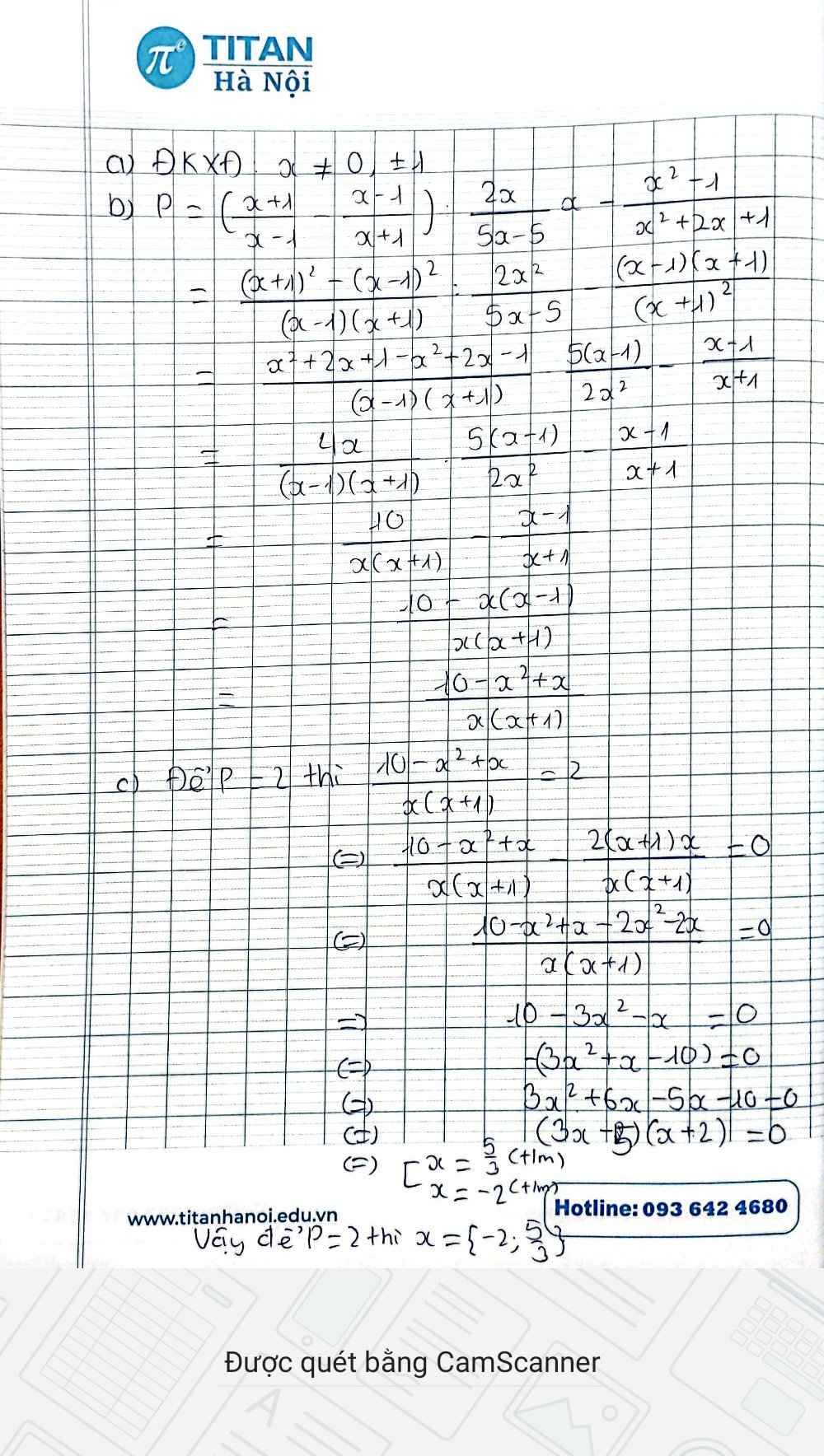Cho biểu thức P=(3/1 - x + 1/√x + 1): 1/√x + 1 A Nêu điều kiện xác định và rút gọn biểu thức P B tìm các giá trị của x để P = 5/4 C Tìm giá trị nhỏ nhất của biểu thức m= x + 12/√x - 1 x 1/P
Hãy nhập câu hỏi của bạn vào đây, nếu là tài khoản VIP, bạn sẽ được ưu tiên trả lời.


1. ĐKXĐ: \(x\ne\pm1\)
2. \(A=\left(\dfrac{x+1}{x-1}-\dfrac{x+3}{x+1}\right)\cdot\dfrac{x+1}{2}\)
\(=\dfrac{\left(x+1\right)^2-\left(x-3\right)\left(x-1\right)}{\left(x-1\right)\left(x+1\right)}\cdot\dfrac{x+1}{2}\)
\(=\dfrac{x^2+2x+1-x^2+4x-3}{\left(x-1\right)\left(x+1\right)}\cdot\dfrac{x+1}{2}\)
\(=\dfrac{6x-2}{\left(x-1\right)\left(x+1\right)}\cdot\dfrac{x+1}{2}\)
\(=\dfrac{2\left(x-3\right)\left(x+1\right)}{2\left(x-1\right)\left(x+1\right)}\)
\(=\dfrac{x-3}{x-1}\)
3. Tại x = 5, A có giá trị là:
\(\dfrac{5-3}{5-1}=\dfrac{1}{2}\)
4. \(A=\dfrac{x-3}{x-1}\) \(=\dfrac{x-1-3}{x-1}=1-\dfrac{3}{x-1}\)
Để A nguyên => \(3⋮\left(x-1\right)\) hay \(\left(x-1\right)\inƯ\left(3\right)=\left\{1;-1;3;-3\right\}\)
\(\Rightarrow\left\{{}\begin{matrix}x-1=1\\x-1=-1\\x-1=3\\x-1=-3\end{matrix}\right.\Rightarrow\left\{{}\begin{matrix}x=2\left(tmđk\right)\\x=0\left(tmđk\right)\\x=4\left(tmđk\right)\\x=-2\left(tmđk\right)\end{matrix}\right.\)
Vậy: A nguyên khi \(x=\left\{2;0;4;-2\right\}\)

Kết quả rút gọn: \(P=\frac{\sqrt{x}+2}{\sqrt{x}-1}\)
\(M=\frac{x+12}{\sqrt{x}-1}.\frac{\sqrt{x}-1}{\sqrt{x}+2}=\frac{x+12}{\sqrt{x}+2}\)
\(M=\frac{x-4+16}{\sqrt{x}+2}=\sqrt{x}-2+\frac{16}{\sqrt{x}+2}=\left(\sqrt{x}+2+\frac{16}{\sqrt{x}+2}\right)-4\)
Âp dụng BĐT AM-GM cho 2 số không âm ta có:
\(M\ge2\sqrt{\left(\sqrt{x}+2\right).\frac{16}{\sqrt{x}+2}}-4=2.4-4=4\)
Vậy min M =4. Dấu bằng xảy ra \(\Leftrightarrow\left(\sqrt{x}+2\right)^2=16\Leftrightarrow\sqrt{x}+2=4\Leftrightarrow\sqrt{x}=2\Leftrightarrow x=4\left(tm\right)\)
\(P=\left(\frac{3}{x-1}+\frac{1}{\sqrt{x}+1}\right):\frac{1}{\sqrt{x}+1}\) \(ĐKXĐ:x\ne1\)
\(P=\left(\frac{3}{x-1}+\frac{\sqrt{x}-1}{x-1}\right):\frac{1}{\sqrt{x}+1}\)
\(P=\frac{\sqrt{x}+2}{x-1}.\left(\sqrt{x}+1\right)\)
\(P=\frac{\sqrt{x}+2}{\sqrt{x}-1}\)
b) theo câu a) \(P=\frac{\sqrt{x}+2}{\sqrt{x}-1}\) với \(ĐKXĐ:x\ne1\)
theo bài ra \(P=\frac{5}{4}\)thì \(\Leftrightarrow\frac{\sqrt{x}+2}{\sqrt{x}-1}=\frac{5}{4}\)
\(\Leftrightarrow\left(\sqrt{x}+2\right).4=\left(\sqrt{x}-1\right).5\)
\(\Leftrightarrow4\sqrt{x}+8=5\sqrt{x}-5\)
\(\Leftrightarrow-\sqrt{x}+13=0\)
\(\Leftrightarrow-\sqrt{x}=-13\)
\(\Leftrightarrow\sqrt{x}=13\)
\(\Leftrightarrow x=169\)
vậy \(x=169\)khi \(P=\frac{5}{4}\)

a: ĐKXĐ: x>=0; x<>1
\(A=\dfrac{x\sqrt{x}+1}{x-1}-\dfrac{x-1}{\sqrt{x}+1}\)
\(=\dfrac{x\sqrt{x}+1-\left(x-1\right)\left(\sqrt{x}-1\right)}{x-1}\)
\(=\dfrac{x\sqrt{x}+1-x\sqrt{x}+x+\sqrt{x}-1}{x-1}=\dfrac{x+\sqrt{x}}{x-1}\)
\(=\dfrac{\sqrt{x}}{\sqrt{x}-1}\)
b: Khi x=9/4 thì A=3/2:1/2=3/2*2=3

Đề bài là \(B=\dfrac{\left(x-1\right)^2-4}{\left(2x+1\right)^2-\left(x+2\right)^2}\) hay là \(B=\dfrac{\left(x-1\right)^2-4}{\left(2x+1\right)^2}-\left(x+2\right)^2?\)
\(\dfrac{\left(x-1\right)^2-4}{\left(2x+1\right)^2-\left(x+2\right)^2}\)
viết lại biểu thức

Bài 1: ĐKXĐ:`x + 3 ne 0` và `x^2+ x-6 ne 0 ; 2-x ne 0`
`<=> x ne -3 ; (x-2)(x+3) ne 0 ; x ne2`
`<=>x ne -3 ; x ne 2`
b) Với `x ne - 3 ; x ne 2` ta có:
`P= (x+2)/(x+3) - 5/(x^2 +x -6) + 1/(2-x)`
`P = (x+2)/(x+3) - 5/[(x-2)(x+3)] + 1/(2-x)`
`= [(x+2)(x-2)]/[(x-2)(x+3)] - 5/[(x-2)(x+3)] - (x+3)/[(x-2)(x+3)]`
`= (x^2 -4)/[(x-2)(x+3)] - 5/[(x-2)(x+3)] - (x+3)/[(x-2)(x+3)]`
`=(x^2 - 4 - 5 - x-3)/[(x-2)(x+3)]`
`= (x^2 - x-12)/[(x-2)(x+3)]`
`= [(x-4)(x+3)]/[(x-2)(x+3)]`
`= (x-4)/(x-2)`
Vậy `P= (x-4)/(x-2)` với `x ne -3 ; x ne 2`
c) Để `P = -3/4`
`=> (x-4)/(x-2) = -3/4`
`=> 4(x-4) = -3(x-2)`
`<=>4x -16 = -3x + 6`
`<=> 4x + 3x = 6 + 16`
`<=> 7x = 22`
`<=> x= 22/7` (thỏa mãn ĐKXĐ)
Vậy `x = 22/7` thì `P = -3/4`
d) Ta có: `P= (x-4)/(x-2)`
`P= (x-2-2)/(x-2)`
`P= 1 - 2/(x-2)`
Để P nguyên thì `2/(x-2)` nguyên
`=> 2 vdots x-2`
`=> x -2 in Ư(2) ={ 1 ;2 ;-1;-2}`
+) Với `x -2 =1 => x= 3` (thỏa mãn ĐKXĐ)
+) Với `x -2 =2 => x= 4` (thỏa mãn ĐKXĐ)
+) Với `x -2 = -1=> x= 1` (thỏa mãn ĐKXĐ)
+) Với `x -2 = -2 => x= 0`(thỏa mãn ĐKXĐ)
Vậy `x in{ 3 ;4; 1; 0}` thì `P` nguyên
e) Từ `x^2 -9 =0`
`<=> (x-3)(x+3)=0`
`<=> x= 3` hoặc `x= -3`
+) Với `x=3` (thỏa mãn ĐKXĐ) thì:
`P = (3-4)/(3-2)`
`P= -1/1`
`P=-1`
+) Với `x= -3` thì không thỏa mãn ĐKXĐ
Vậy với x= 3 thì `P= -1`

M xác định
\(\Leftrightarrow\hept{\begin{cases}x-1\ne0\\x^2-x\ne0\end{cases}\Leftrightarrow}\hept{\begin{cases}x\ne1\\x\left(x-1\right)\ne0\end{cases}\Leftrightarrow\hept{\begin{cases}x\ne1\\x\ne0;x\ne1\end{cases}}\Leftrightarrow}\hept{\begin{cases}x\ne1\\x\ne0\end{cases}}\)
Vậy ĐKXĐ của M là \(\hept{\begin{cases}x\ne1\\x\ne0\end{cases}}\)
\(M=\frac{3}{x-1}+\frac{1}{x^2-x}=\frac{3}{x-1}+\frac{1}{x\left(x-1\right)}=\frac{3x}{x\left(x-1\right)}+\frac{1}{x\left(x-1\right)}=\frac{3x+1}{x\left(x-1\right)}\)
Thay x=5 ta có:
\(M=\frac{3.5+1}{5\left(5-1\right)}=\frac{15+1}{5.4}=\frac{16}{20}=\frac{4}{5}\)
Vậy \(M=5\)tại x=5
\(M=0\)
\(\Leftrightarrow\frac{3x+1}{x\left(x-1\right)}=0\Leftrightarrow3x+1=0\Leftrightarrow x=-\frac{1}{3}\)( thỏa mãn đkxđ)
Vậy với \(x=-\frac{1}{3}\)thì \(M=0\)
\(M=-1\)
\(\Leftrightarrow\frac{3x+1}{x\left(x-1\right)}=-1\Leftrightarrow3x+1=-x^2+x\Leftrightarrow x^2+2x+1=0\Leftrightarrow\left(x+1\right)^2=0\Leftrightarrow x=-1\)
Vậy với \(x=-1\)thì \(M=-1\)


a: ĐKXĐ: x>=0; x<>1
\(P=\dfrac{-3+\sqrt{x}-1}{x-1}\cdot\dfrac{\sqrt{x}+1}{1}=\dfrac{\sqrt{x}-4}{\sqrt{x}-1}\)
b: Để P=5/4 thì \(\dfrac{\sqrt{x}-4}{\sqrt{x}-1}=\dfrac{5}{4}\)
=>\(5\sqrt{x}-5=4\sqrt{x}-16\)
=>căn x=-11(loại)